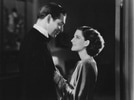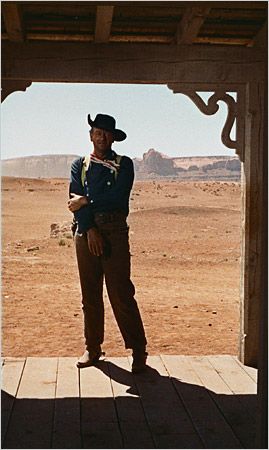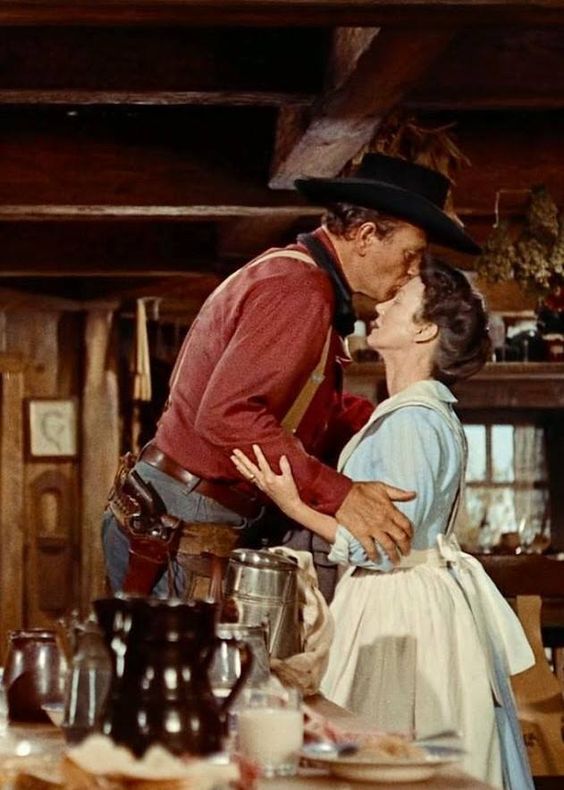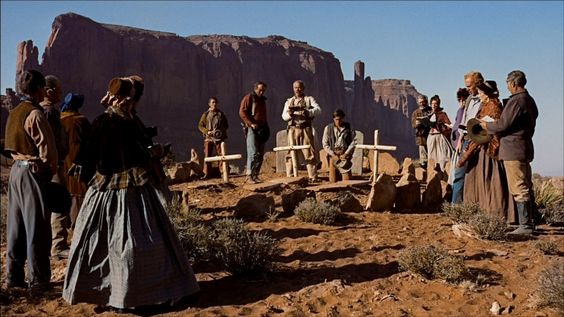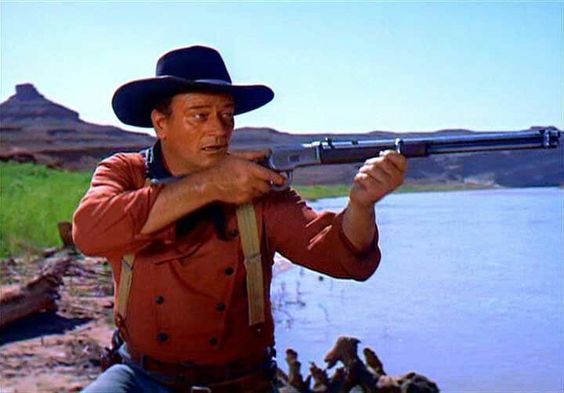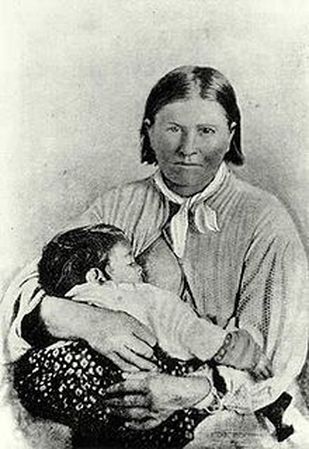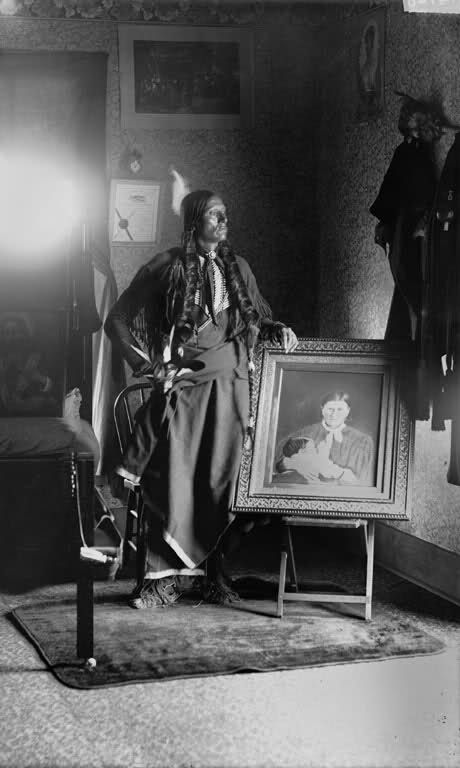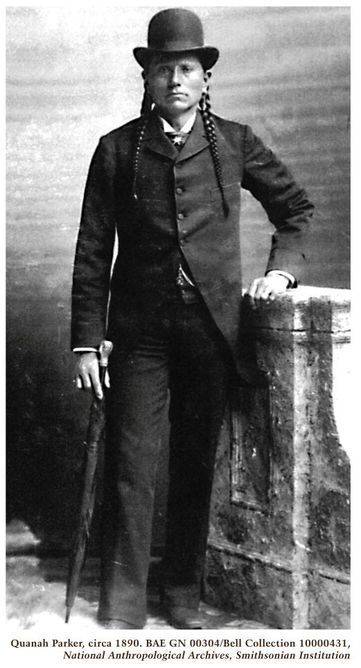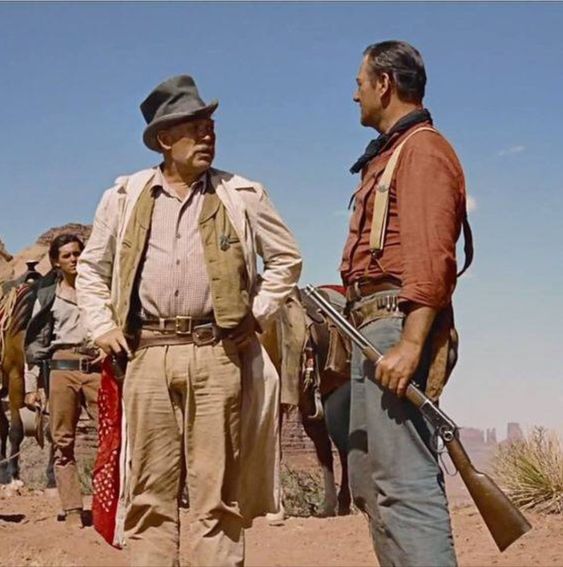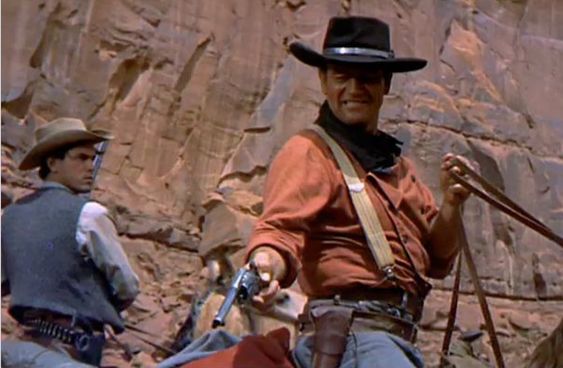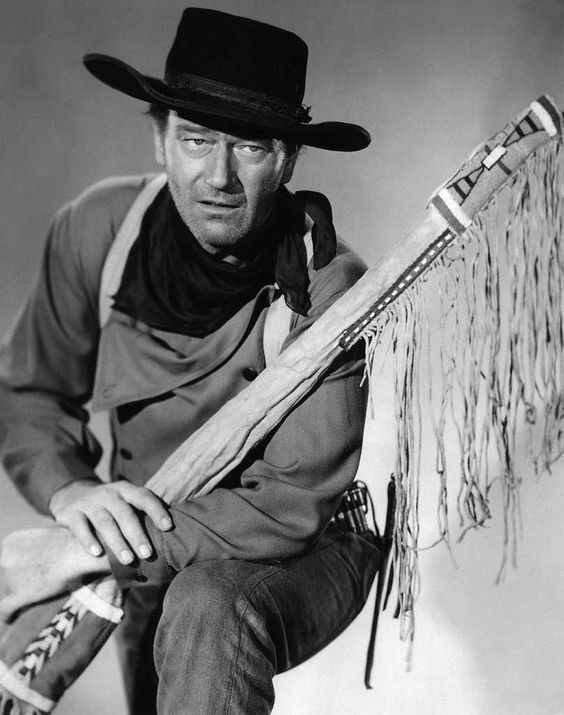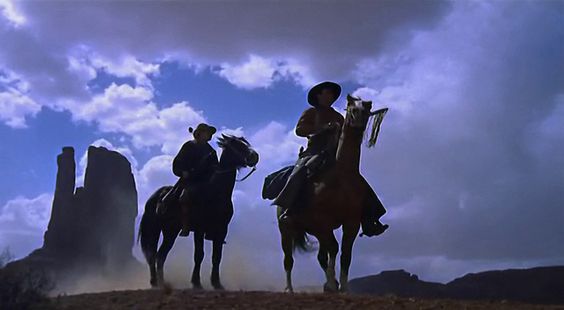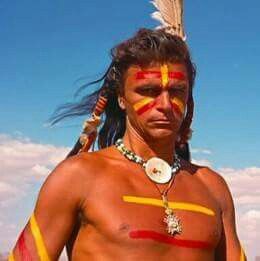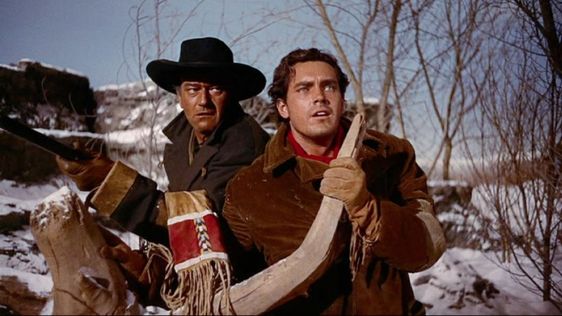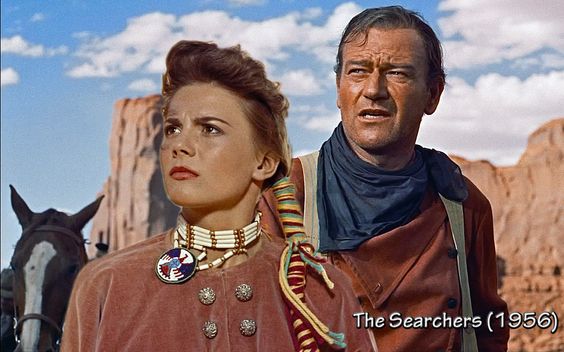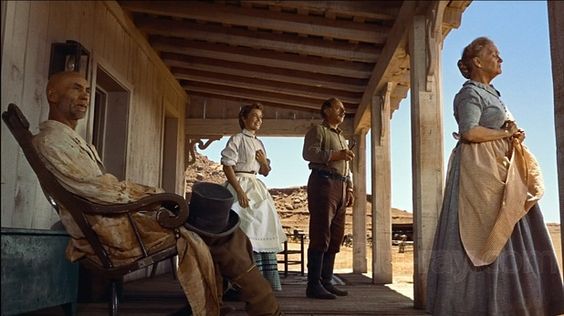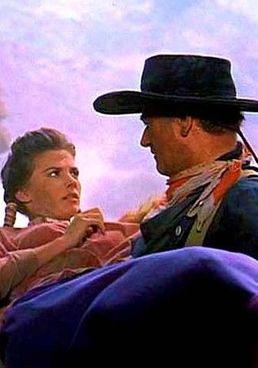|
Nutshell Review: The Searchers (1956)
Written for Natalie Wood Blogathon (7/18): https://bit.ly/2zI9pYd Director: John Ford Starring: John Wayne, Jeffrey Hunter, Vera Miles, Ward Bond, Natalie Wood Studio: Warner Bros. My IMDB Rating: 10 Viewing: Warner Bros. Blu-ray Plot: Ethan Edwards, a former confederate soldier, returns home from a mysterious absence 3 years after the war’s conclusion just in time to see his brother murdered, his true love raped & murdered & his nieces kidnapped. Along with his nephew, Ethan hunts for 7 years for the band of Comanche’s responsible in order the exact revenge and kill the now defiled niece Debbie. |
Thoughts: The Searchers is not a Natalie Wood movie. She has limited screen time and she only utters a few sentences, but her character’s presence looms over the film like a cloud on a rainy day. The Searchers is a John Ford film. It is a John Wayne movie. It also happens to be one of the greatest American films ever made & influenced a generation of filmmakers including Martin Scorsese, Francis Ford Coppola, Curtis Hansen, Steven Spielberg, Peter Bogdanovich, Paul Schrader & John Milius. Debbie, played by Woods, is the representation of an ideal that propels the story forward as Wayne’s Ethen Edwards seeks vengeance for Debbie’s kidnapping and the murder and rape of the love of Ethan’s life, his brother’s wife Martha. The Searchers is a dark film, devoid of the wholesome and uplifting icons of the typical American Western film, focusing instead on overt hatred, racism and fear throughout. At its core, however, The Searchers is about belonging, about family and most of all about the struggle in one man’s soul to find his place among the two.
The movie itself was based on a serialized story written by Allen LeMay published in The Saturday Evening Post in 1950 called “The Avenging Texans” and was later published as a novel called The Searchers. The origins for the story, however, go back further than the open title, “Texas 1868,” to the 1830’s when a Comanche attack on the Parker homestead in northwestern Texas resulted in the murder of several family members and the kidnapping of nine year old Cynthia Ann Parker, along with several other members of her family. It was common practice for Native tribes to attack, kill or hold for ransom Texas homesteaders in the mid-1800’s as settlers encroached upon, then took, the vast tracks of lands belonging to Native Americans. Where Cynthia Ann’s story stands out, however, is twofold, in that her uncle famously spent years searching for her in an effort to bring her back to her remaining family & that one of her sons, born of a Comanche chief rose to become the last great chief of the Comanche tribe. Sadly, when Cynthia was finally found 24 years later, along with a young daughter, she no longer could speak English, did not remember her white family & had no interest in living in white community. While her exact death is subject to debate, she died within 10 years of being ‘found’, not long after her young daughter. She was never able to see her 2 sons, also born of the Comanche chief, who was primarily responsible for the raid on her family’s home, nor did she know if they lived or died while she was alive. Her son Quanah, searched for his mother and eventually took her last name. While a young warrior he led raids on white settlements and was believed to have killed many, but later was instrumental in negotiating a peace settlement with the US government. He lobbied before congress and once hosted Teddy Roosevelt at his home before dying in 1911 at the age of 66.
Debbie, then, is partially based on Cynthia Ann, and Ethen on her uncle, while Frank Nugent’s script makes several subtle & off-hand references to the times and the incidents around the story, most notably in the belief that Ethan holds that once captured “and of a certain age” the white girls were no longer suitable for civilization. While The Searchers is a brutal movie, most of the barbarism takes place off camera, with only the pained look of Ethan/Wayne reflecting the horrors he’s witnessed. The brutality on both sides is evidenced in the initial raid on the Edward’s home when Ethan desperately searches for his brother’s wife Martha (the woman he loves) only to find her in the root cellar, clearly raped & murdered. His horror is compounded when the family dog alerts him to Debbie’s doll, which has been left behind when she was taken. Later, the Comanche chief responsible for the raid, Scar, admits that the killing was payment for the death of his 2 sons at the hands of other white settlers.
Debbie, then, is partially based on Cynthia Ann, and Ethen on her uncle, while Frank Nugent’s script makes several subtle & off-hand references to the times and the incidents around the story, most notably in the belief that Ethan holds that once captured “and of a certain age” the white girls were no longer suitable for civilization. While The Searchers is a brutal movie, most of the barbarism takes place off camera, with only the pained look of Ethan/Wayne reflecting the horrors he’s witnessed. The brutality on both sides is evidenced in the initial raid on the Edward’s home when Ethan desperately searches for his brother’s wife Martha (the woman he loves) only to find her in the root cellar, clearly raped & murdered. His horror is compounded when the family dog alerts him to Debbie’s doll, which has been left behind when she was taken. Later, the Comanche chief responsible for the raid, Scar, admits that the killing was payment for the death of his 2 sons at the hands of other white settlers.
The raid & kidnapping sets the story in motion, but beforehand the foundation of Ethan’s existence and its impact on the story are set in place the moment he is seen by Martha riding up to the Edward’s home. He is cold & almost dismissive towards his brother, but kisses Martha on the forehead before entering the home. His eyes linger over Martha as he speaks to her or anyone else; his voice is softer and more affectionate. She too, seems beside herself in Ethan’s presence, stroking his coat & watching him as he speaks to others. In the novel, Martha is not aware of Ethan’s love for her, but here it is clear that this is a 2 way case of unrequited love, and likely responsible for the 3 years Ethan has stayed away. Ethan’s sniping at his brother makes it clear what the ending vividly shows; that Ethan is an outsider and his presence would be disruptive to the family unit, whether the Edwards, or later, the Jorgenson’s.
Director John Ford & star John Wayne made more than 15 movies together, with The Searchers being their 9th. Ford essentially created Wayne’s mythology in movies like Stagecoach (’39), Fort Apache (’48) & She Wore a Yellow Ribbon (’49), but like he did in ‘reinventing the western’ with Stagecoach, Ford utilizes Wayne’s personae to play against type. Ethan is not a noble warrior; he is not righteous in his cause; he is racist, fueled by hatred and bloodthirsty (Imagine how an audience in 1956 would have viewed Ethan/Wayne emerging from Scar’s teepee with a scalp in his hand?). His past is even left vague, but may include robbery (the freshly minted coins) & murder (Clayton’s line about Ethan ‘matching a lot of descriptions’). In recalibrating Wayne’s image, at least for 2 hours, Ford was able to not only extract arguably the best performance of Wayne’s career, but to readjust the idea of what a hero is. Ethan practically spits “Comanch” every time he says it & looks upon the white captives at the fort with more disgust that pity, noting “they ain’t white…anymore.” Ethan also spends a good deal of the movie reminding his adopted nephew of his 1/8th Cherokee blood, calling him an assortment of derogatory names. The shorthand in the Ford/Wayne mythology allowed for such manipulation of expectations, while keeping the viewer firmly rooting for Ethan to succeed.
Director John Ford & star John Wayne made more than 15 movies together, with The Searchers being their 9th. Ford essentially created Wayne’s mythology in movies like Stagecoach (’39), Fort Apache (’48) & She Wore a Yellow Ribbon (’49), but like he did in ‘reinventing the western’ with Stagecoach, Ford utilizes Wayne’s personae to play against type. Ethan is not a noble warrior; he is not righteous in his cause; he is racist, fueled by hatred and bloodthirsty (Imagine how an audience in 1956 would have viewed Ethan/Wayne emerging from Scar’s teepee with a scalp in his hand?). His past is even left vague, but may include robbery (the freshly minted coins) & murder (Clayton’s line about Ethan ‘matching a lot of descriptions’). In recalibrating Wayne’s image, at least for 2 hours, Ford was able to not only extract arguably the best performance of Wayne’s career, but to readjust the idea of what a hero is. Ethan practically spits “Comanch” every time he says it & looks upon the white captives at the fort with more disgust that pity, noting “they ain’t white…anymore.” Ethan also spends a good deal of the movie reminding his adopted nephew of his 1/8th Cherokee blood, calling him an assortment of derogatory names. The shorthand in the Ford/Wayne mythology allowed for such manipulation of expectations, while keeping the viewer firmly rooting for Ethan to succeed.
Once Ethan & Martin (Jeffrey Hunter) embark on their epic quest to find Debbie, Ford (and Warner Bros. VistaVision technology)utilizes every bit of the Monument Valley location to illustrate both the time & space involved, placing both actors against the timeless rock formations, while creating the elliptical storytelling device of the letter. As only the passing of time can wither and change the rocks, the searchers must move through the seasons and the years to get closer to Debbie. Ethan expresses the feelings that are summed up in his “just as sure as the turnin’ of the earth” speech to Martin, that no matter how much time passes they will not stop. Martin’s letter to Debbie, while providing a respite from the tension of the search, also helps to explain the length of their search with small verbal markers like the distance between letters & Laurie’s (Vera Miles) frustration with Martin’s absence. Space is the easiest marker to see, however because not only is the vast landscape that Ford & cinematographer Winton Hoch (Quiet Man & She Wore a Yellow Ribbon) shoot spread out in every shot, but the actors are deliberately made small against it, sometimes only holding a small place in the frame. Ethan even comments at the great distance of the trek by naming Indian agency offices & forts that would have spanned more than 2,000 miles.
While The Searchers is a reflection of both the era in which it was made and the era in which it was supposed to have taken place, it is simply about community and family. The Edwards live in a vast expanse, but the intimacy of their home shields them from what is outside. The routine of their lives, the setting of the table, the smoking of a pipe by the fire, and the working of the land is shattered first when Ethan appears and then again when the raid destroys their home. Ethan does not belong within the community/family, having cast himself out first by going to war & then through his mysterious 3 year absence, because he harbors love for his sister-in-law. Such is his disruption that he twice interrupts the sacred song of “Shall We Gather at the River, first at the Edwards’ funerals and then at the wedding between Laurie & Charlie (E. Buscombe p. 55). Martin is also an outsider, having been found by Ethan & adopted by the Edwards. He belongs, but he is not a part of the family. Debbie ultimately belongs to 2 families/communities and the struggle between them nearly destroys everyone in both communities, but that struggle helps bond Martin & Ethan as a small, if only temporary, family. As the moral center of the film, it is Martin who never waivers from rebuilding his lost family. Finally, the Jorgensen’s replaces the Edwards by taking in both Debbie & Martin, creating a larger, safer family. Ethan, however, still does not belong and is forced to turn back from the threshold and left to seemingly wander. He is without community and family, perhaps as repayment for past crimes, perhaps because he knows that experience has left him incapable.
While The Searchers is a reflection of both the era in which it was made and the era in which it was supposed to have taken place, it is simply about community and family. The Edwards live in a vast expanse, but the intimacy of their home shields them from what is outside. The routine of their lives, the setting of the table, the smoking of a pipe by the fire, and the working of the land is shattered first when Ethan appears and then again when the raid destroys their home. Ethan does not belong within the community/family, having cast himself out first by going to war & then through his mysterious 3 year absence, because he harbors love for his sister-in-law. Such is his disruption that he twice interrupts the sacred song of “Shall We Gather at the River, first at the Edwards’ funerals and then at the wedding between Laurie & Charlie (E. Buscombe p. 55). Martin is also an outsider, having been found by Ethan & adopted by the Edwards. He belongs, but he is not a part of the family. Debbie ultimately belongs to 2 families/communities and the struggle between them nearly destroys everyone in both communities, but that struggle helps bond Martin & Ethan as a small, if only temporary, family. As the moral center of the film, it is Martin who never waivers from rebuilding his lost family. Finally, the Jorgensen’s replaces the Edwards by taking in both Debbie & Martin, creating a larger, safer family. Ethan, however, still does not belong and is forced to turn back from the threshold and left to seemingly wander. He is without community and family, perhaps as repayment for past crimes, perhaps because he knows that experience has left him incapable.
Within the darkness of The Searchers there is redemption. Ethan forgives Debbie and returns her to white civilization & he bequests his worldly possessions to Martin, acknowledging that they too are family. Even so, Ethan cannot be a part of their lives any longer. He, like his mirror image, Comanche chief Scar, cannot remain a part of a community because somehow they each sacrificed a piece of their humanity for revenge. Scar ultimately dies, but in a ‘fate worse than death’ Ethan is made to wander. The Searchers was the pinnacle of the Ford/Wayne moviemaking partnership and was a break from most of their mythmaking, but it serves as a reckoning on the ideas and possibilities in the Western. As the influence of the picture grew during the late ‘60’s and early ‘70’s it was clear that The Searchers was a line in the sand not just for a peak in quality in the Western, but as a marker for creating depth and nuance in a hero.
Sadly, Cynthia Ann Parker was never able to enjoy the life that is promised Debbie at the conclusion of The Searchers. Unlike Debbie, who is able to speak English, Cynthia Ann could never explain the life she so desired to return to. She did not feel the love that Ethan expressed to her when he told her they were ‘going home.’ Cynthia Ann’s mere presence brought shame to her family; there were no willing adopters like the Jorgensens. She died of a broken heart at an unrecorded time. If the mythmaking and myth-busting of The Searchers were true to its source material, perhaps Natalie Wood’s Debbie would have had more depth, more presence. But as it is she is an important piece of The Searchers, but only as an idea or a belief system, not as an actual character.
Sadly, Cynthia Ann Parker was never able to enjoy the life that is promised Debbie at the conclusion of The Searchers. Unlike Debbie, who is able to speak English, Cynthia Ann could never explain the life she so desired to return to. She did not feel the love that Ethan expressed to her when he told her they were ‘going home.’ Cynthia Ann’s mere presence brought shame to her family; there were no willing adopters like the Jorgensens. She died of a broken heart at an unrecorded time. If the mythmaking and myth-busting of The Searchers were true to its source material, perhaps Natalie Wood’s Debbie would have had more depth, more presence. But as it is she is an important piece of The Searchers, but only as an idea or a belief system, not as an actual character.
Category: Western
See Also: Naked Spur (Dir. Anthony Mann. Stars: James Stewart, Janet Leigh & Robert Ryan. 1953)
Pursued (Dir. Raoul Walsh. Stars: Robert Mitchum, Teresa Wright, Judith Anderson. 1947)
Stagecoach (Dir. John Ford. Stars: John Wayne, Clair Trevor, John Carradine. 1939)
Red River (Dir. Howard Hawks. Stars: John Wayne, Mongomery Clift. 1948)
Random Notes & Quotes:
*Young Debbie was played by Natalie Wood’s 8 year old sister Lana and came as part of the package to secure Natalie. The girls’ mother agreed to Natalie’s part only if Lana played the younger version.
*The iconic final shot of Wayne, framed in the Jorgensen’s door way with his left hand holding his right arm is an homage to Wayne’s acting hero & mentor Harry Carry who often did the same in his early Westerns. Carey’s widow Olive played Mrs. Jorgensen and was standing just behind the camera when the shot was made.
*In 2012 Sight & Sound ranked The Searchers #7 greatest film ever made. A testament to how the film contuse to increase in esteem, in 1972 it was the 17th rated film.
*The Searchers was the #11 film at the box office in 1956, but didn’t receive a single Oscar nomination.
*Financier C.V. Whitney, who took Pan Am airlines from 1 route local airplane to the largest in the world, also held onto his stake in Gone With the Wind, when most people sold their share to MGM. His widow was still earning money well into the 70’s on the investment. John Ford staged a fight between extras in themes hall purely to frighten Whitney.
*Ford repeatedly hired the local Navajos when he shot in Monument Valley, providing them with not only wages well beyond their normal intake, but would throw parties & celebrations with them while in the valley. They rewarded Ford with a ceremonial deer skin as a token of their esteem.
Sources:
The Searchers: The Making of an American Legend. Glenn Frankel. Bloomsbury. 2013
The Searchers. Edward Buscombe. BFI Classics. 2000.
John Ford: The Man & His Films. Tag Gallagher. University of California Press. 1986.
Print the Legend: The Life & Times of John Ford. Scott Eyman. Simon & Schuster. 1999.
See Also: Naked Spur (Dir. Anthony Mann. Stars: James Stewart, Janet Leigh & Robert Ryan. 1953)
Pursued (Dir. Raoul Walsh. Stars: Robert Mitchum, Teresa Wright, Judith Anderson. 1947)
Stagecoach (Dir. John Ford. Stars: John Wayne, Clair Trevor, John Carradine. 1939)
Red River (Dir. Howard Hawks. Stars: John Wayne, Mongomery Clift. 1948)
Random Notes & Quotes:
*Young Debbie was played by Natalie Wood’s 8 year old sister Lana and came as part of the package to secure Natalie. The girls’ mother agreed to Natalie’s part only if Lana played the younger version.
*The iconic final shot of Wayne, framed in the Jorgensen’s door way with his left hand holding his right arm is an homage to Wayne’s acting hero & mentor Harry Carry who often did the same in his early Westerns. Carey’s widow Olive played Mrs. Jorgensen and was standing just behind the camera when the shot was made.
*In 2012 Sight & Sound ranked The Searchers #7 greatest film ever made. A testament to how the film contuse to increase in esteem, in 1972 it was the 17th rated film.
*The Searchers was the #11 film at the box office in 1956, but didn’t receive a single Oscar nomination.
*Financier C.V. Whitney, who took Pan Am airlines from 1 route local airplane to the largest in the world, also held onto his stake in Gone With the Wind, when most people sold their share to MGM. His widow was still earning money well into the 70’s on the investment. John Ford staged a fight between extras in themes hall purely to frighten Whitney.
*Ford repeatedly hired the local Navajos when he shot in Monument Valley, providing them with not only wages well beyond their normal intake, but would throw parties & celebrations with them while in the valley. They rewarded Ford with a ceremonial deer skin as a token of their esteem.
Sources:
The Searchers: The Making of an American Legend. Glenn Frankel. Bloomsbury. 2013
The Searchers. Edward Buscombe. BFI Classics. 2000.
John Ford: The Man & His Films. Tag Gallagher. University of California Press. 1986.
Print the Legend: The Life & Times of John Ford. Scott Eyman. Simon & Schuster. 1999.
